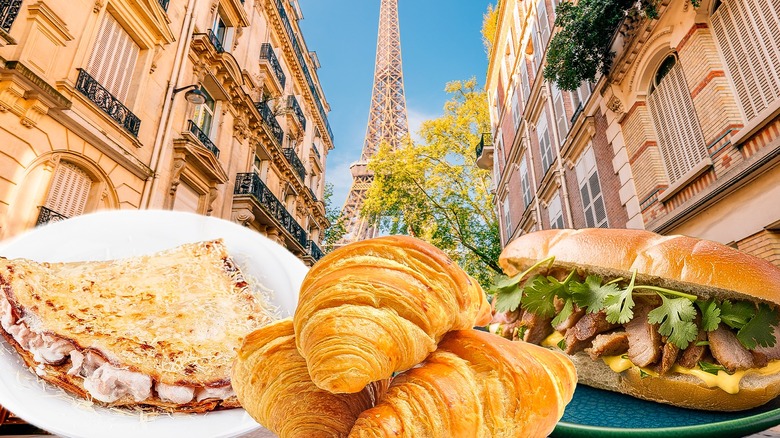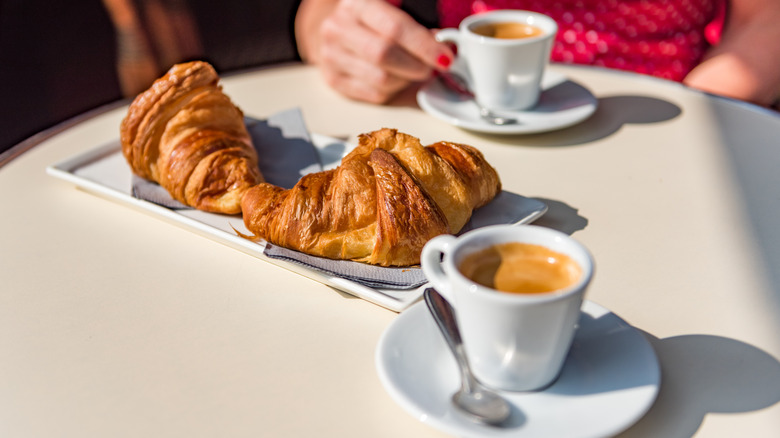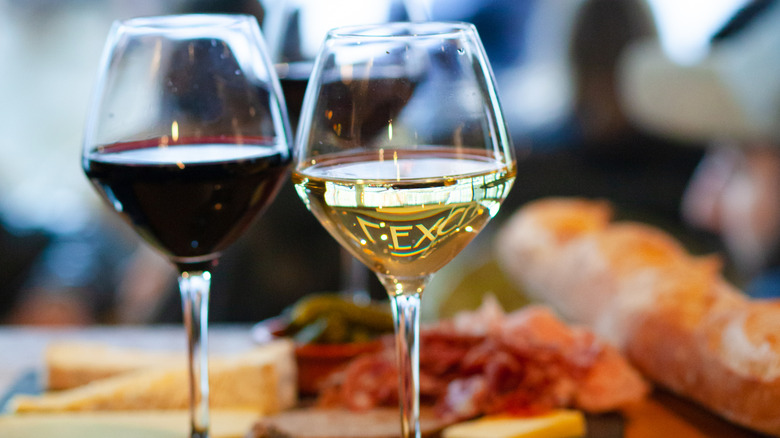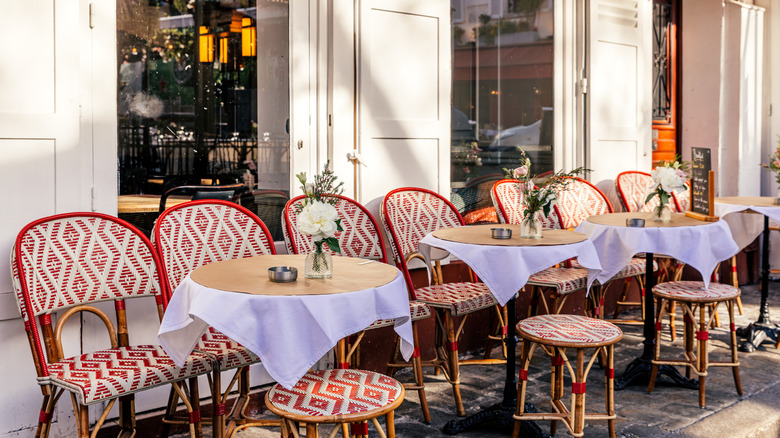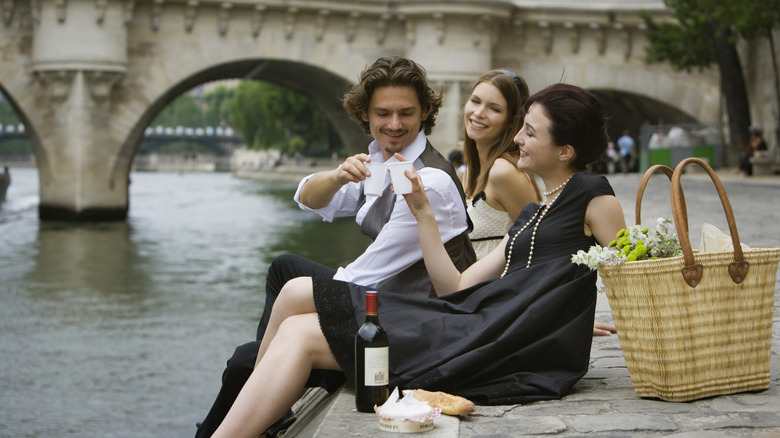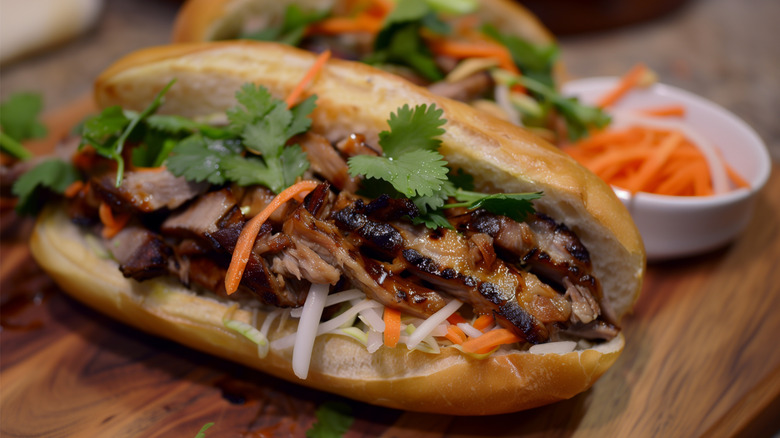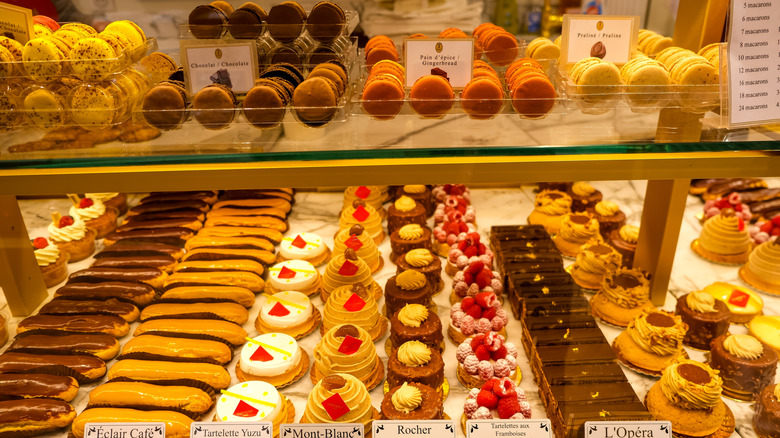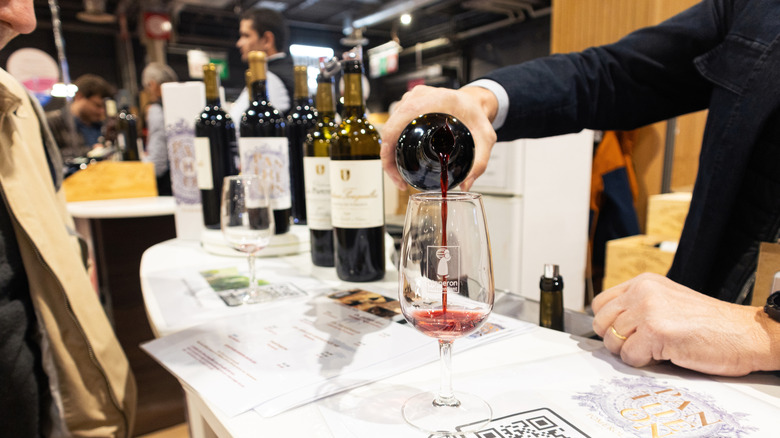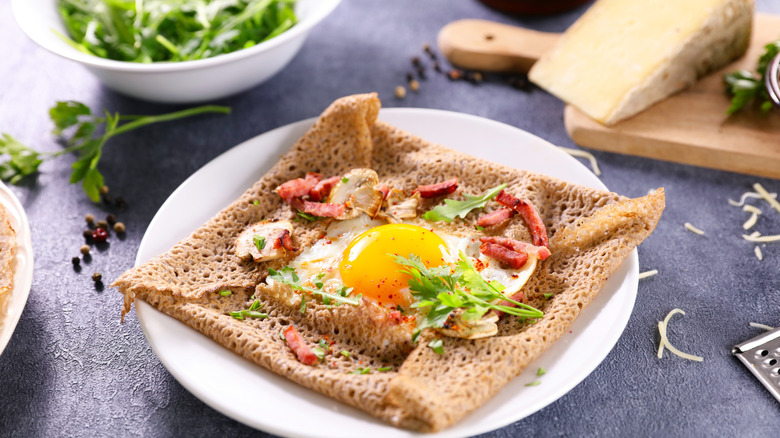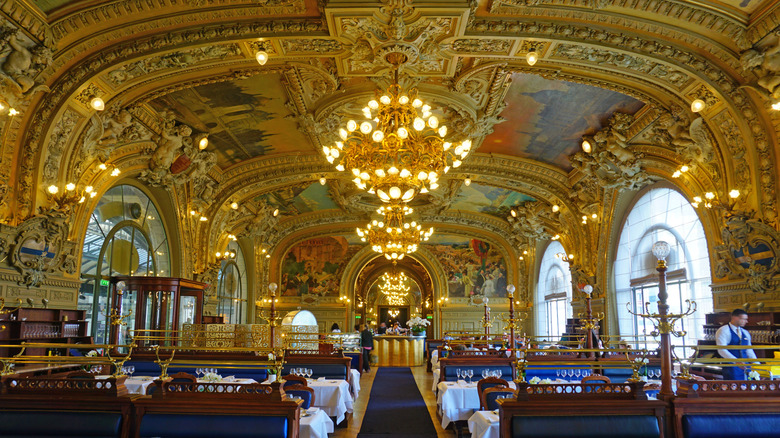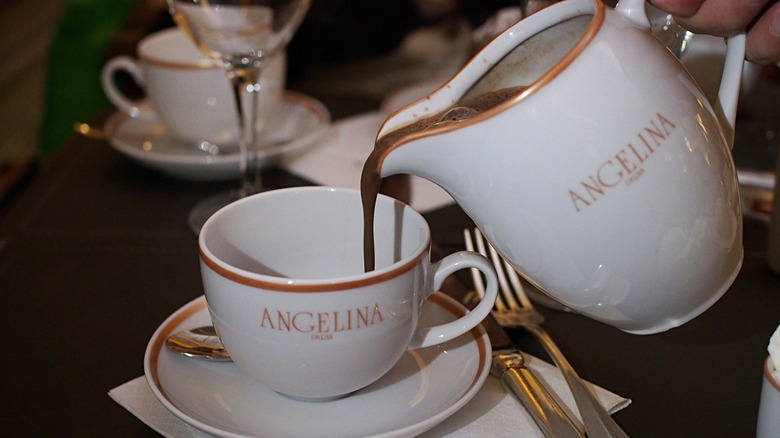What To Eat With 24 Hours In Paris
Paris is known for its food, not to mention its charming cafes and world-renowned restaurants. Not only will you find traditional French specialties, including many that originated or became popular here, but Paris is a vibrant city where you can also sample dishes and snacks from just about every country in the world. But what if you don't have a lot of time to explore all of the City of Light's culinary offerings?
In the two decades I've lived and eaten in Paris, the amount of good meals, snacks, and desserts I've savored here would be hard to count. Still, there are definitely some highlights, and some foods and drinks I'd consider "musts" for anyone who visits. Here's where to find the best things to eat and drink if you only have 24 hours in the capital city of France.
Breakfast
Start your day in Paris with a cup of coffee. It's been a part of Parisian life since the 17th century, but many people are surprised to find that Parisians aren't particularly interested in specialty coffees. You can find places to get those if that's what you crave, but a real, Paris-style coffee is a very basic one you drink at a café terrace. A French coffee (un café) is more like an espresso, so if you want to go a little lighter on the caffeine, ask for a café américain (filtered coffee that's a bit watered down and served in a larger cup), or, for decaf, un déca. A café crème is roughly equivalent to a latte, while a café noisette is short with just a touch of milk. If you're on a budget, ask for un express, a small shot of espresso that usually costs only around 2 euros or so — a bargain for a Parisian café ambiance plus a shot of energy to start your day.
French breakfasts are typically light and tend to lean toward sweet rather than savory, so this is the perfect time to enjoy one of France's most famous pastries. Croissants are usually eaten plain in France, but you may be able to sneak some jam onto yours. Still, fresh-baked, buttery, and flaky, it should be perfect on its own. Any Parisian boulangerie (bakery) worth its salt will sell fresh croissants, but if you're a true aficionado, you can head to the boulangerie that won the annual competition for the best croissant in Paris.
Apéro (Aperitif)
"Apéro" translates to aperitif, but it's more than just a quick drink before dinner. The apéro is a cultural institution for many French people. When they have time, lunch or dinner is preceded by this often leisurely serving of drinks and snacks, which can be lingered over for hours. If this sounds perfect to you, you could set aside a little time for an apéro experience in Paris. You'll find lots of restaurants, bars, and tapas bars that offer good apéro opportunities, but since you're only in the City of Light for one day, why not kill two birds with one stone and visit a place with a view? Many museums, high-end hotels, and other locales have rooftop bars that offer stunning panoramic vistas of one of the most beautiful cities on earth.
Some of the most popular rooftop bars in Paris include the terraces of the Galeries Lafayette and Printemps department stores (you can also visit these without ordering anything, just for the view), ROOF at the Madame Rêve Hotel, and the rooftop bar at the Hôtel Dame des Arts. Whether you choose one of these or another of Paris's many rooftop bars, check your destination's website before you go, since many of them aren't open year-round. If you're more interested in the drinks side of the apéro experience, Harry's Bar is famous for its extensive range of cocktails, as well as its rich history (among others, Ernest Hemingway was one of its former patrons).
Lunch
Take a lunch break like a Parisian and head for a café or brasserie. These are restaurants where you can get everything from a coffee or drink to a multi-course meal. Parisians have been dining and, perhaps even more importantly, people-watching in restaurants like these since they began to crop up in the 17th and 18th centuries. No matter where you are in Paris, you'll find a café or brasserie nearby. and just about any meal in one of these eateries will be of decent quality, even in touristy areas. For instance, Le Lutèce, on the bustling Boulevard Saint-Michel, has some delicious beef dishes on its menu. If you're in doubt, try the daily specials or ask your server for recommendations (they're usually honest).
You can also use this as an opportunity to try a traditional French dish like steak tartare, escargots, steak frites (steak served with what are usually exceptionally tasty fries), and onion soup, among many others. If you're not feeling adventurous, don't worry. You'll probably find roast chicken on the menu, too. In fact, roast chicken with fries was recently voted as the French's favorite meal. Most cafes will have fixed-price menus offering multiple courses and options, so if you don't know what to pick, let one of those be your guide. French café meals should be moderately priced, and there are even a few ways you can save additional money when you eat at one. So, sit back, enjoy, and watch the busy waiters and leisurely diners around you while you enjoy your meal.
Picnic
Another iconic Paris food experience is having a picnic on the banks of the Seine or the Canal St Martin. It seems like anyone who's lived here has done this at least once, especially if they were in Paris as a college student or poor youngster just starting out. There won't be tables — or grass, for that matter. Instead, you improvise, sitting on the cobblestone banks along the river. Most Paris picnics include cheese (typically Camembert, one of France's most popular cheeses), wine or bottled water, and possibly some dry sausage or pre-packaged deli meats. Everything, including wine, is usually bought at a local grocery store.
No Parisian picnic would be complete without an iconic French baguette. Although no one knows exactly who invented them or when they were invented, baguettes first became popular here in Paris before spreading to other parts of France, and then the world. You can find freshly baked baguettes at any of the city's more than 1300 boulangeries. Baguettes at just about any Parisian bakery will be good, but if you're looking for the best of the best, look up the winner of Paris's best baguette competition to see if you can stop by the winning boulangerie — ask for a baguette tradition. The 2024 winner of the Best Baguette in Paris is the Boulangerie Utopie, located in the 11th arrondissement (district). My personal favorite is the baguette tradition from Le Délice de Bagnolet, which has placed twice in the top 10.
Banh mi break
Paris is truly a global city, and you'll be able to find good food from just about anywhere here. One of the most delicious international foods you'll find in Paris, as well as one that makes for the perfect quick meal or snack when you're short on time, is banh mi. These sandwiches combine traditional Vietnamese ingredients (in Paris, most commonly lacquered pork) with fresh vegetables, served on a French baguette. The meal traces its origins to Vietnam's days as a French colony.
You'll find banh mi restaurants or stands in many parts of Paris. In my opinion, the best banh mi in the city is made fresh in front of your eyes at Vietnam Sandwich on Rue Montgallet. Fellow bahn mi fans also like Nonette and Saigon Sandwich, both in the 11th arrondissement.
Sweet treat
There are so many possibilities for snacking in Paris, so it's a shame that for most French adults, snacking is considered a bit taboo. Still, you're only here for a day, so take advantage of it! Paris is home to some must-try desserts, and just about any boulangerie will have delicious pastries on offer. Classics include the éclair, pain au chocolat (croissant-like pastry with chocolate in the center), and pain au lait (brioche-like bread in the shape of a small baguette). You're also likely to find fruit and custard tarts and specialties like Paris-Brest, opéras, mille-feuilles (the equivalent of a Napoleon), and more.
Some Parisian bakeries date back centuries, and have been making their specialties for nearly as long. For instance, the oldest bakery in Paris, Stohrer, dates to 1731 and is where the rum baba (a cake soaked in rum) was invented. You can still try one there, or sample some of the bakery's many other mouthwatering treats. Not far from there, in the historic Marais district, is the main Paris branch of candy and sweet shop Méert. Founded in the 17th century, Méert is known for its thin waffle cookies that encase a small layer of vanilla cream. They also sell caramels in several flavors. Be sure to taste a square of chocolate caramel for a stunning, flavorful experience like no other.
If you're longing to taste another iconic French treat, you can find stands and shops throughout the city selling macarons made by Ladurée, probably the pastry's most famous purveyor. The company's main shop on the Champs-Elysées is the prettiest place on the entire legendary avenue, and it's hard to resist sitting down there and having some tea with your macarons.
Wine time
France is famous for its wines, so you may be disappointed to discover that Paris itself doesn't have a famous wine associated with it. There are several very small vineyards in hilly neighborhoods, with the most famous being the one on the slopes of Montmartre. The wine it produces, Clos Montmartre, is served and celebrated during the neighborhood's Fête des Vendanges every year but isn't actually considered very good. Luckily, Paris has plenty of good places to enjoy fine wines from every region of France.
The most Parisian way to enjoy wine is to have a glass with a meal at a café terrace. But if you're a wine aficionado who wants to discover some grands crus or new upstarts, the city has many caves à vin (wine cellars) and bars à vin (wine bars). Wine will usually be served alongside snacks or tapas, since, as the Time Out guide to Paris wine bars aptly puts it, "In Paris, you drink wine with food: not before, not after." Some popular wine bars include Chez Nous and l'Ambassade de Bourgogne, both in the 6th arrondissement, and Le Flamingo (Le Rouge à Lèvres) in the 9th arrondissement. But good wine can be found in countless bars, restaurants, and even grocery stores in Paris. The city is packed with charming bars and cafes where you can savor a glass and soak up the ambiance or an amazing view.
Dinner on a budget: Savory crepes
Something many visitors find surprising is that French crepes have a few differences to other pancakes, and can be savory or sweet. Savory crepes, also called galettes in French, are made with buckwheat flour and filled with ingredients like ham, eggs, cheese, or sausage, and vegetables like lettuce, onions, and tomatoes. They make for a delicious, filling meal.
You can find many crepe restaurants in Paris, often with names relating to the region of Brittany (Bretagne), where savory crepes originated. Breizh Café, which has branches around the city, is one of the most popular crêperies (crepe restaurants) in Paris for a sit-down meal. But you can also order a savory crepe to go. My favorite place for a crepe to-go is Rue Mouffetard, a winding street in the Latin Quarter that's full of shops and eateries. The best-known and loved takeaway crepe place here is Au P´tit Grec. You'll often see a line outside, but it's worth the wait. Having a savory crepe at a sit-down restaurant will cost about the same as many standard meals in Paris, but the huge takeaway crepes at Au P´tit Grec and its fellow restaurants cost a fraction of the price.
Whether you choose sit-down or takeaway, if you have room for dessert, you can order a sweet crepe. Popular choices in Paris include a crepe au sucre (crêpe with melted sugar) and a crêpe au Nutella (Nutella-filled crepe), sometimes with bananas added. You'll usually find even more varieties on offer too.
A high-end Paris dinner
There's delicious food to be had in Paris for budget-minded travelers, but maybe you want to go big and have dinner at a grandiose, luxury Parisian eatery. If that's the case, there's an abundance to choose from, including 121 Michelin-starred restaurants. The 2-star Michelin restaurant Le Jules Verne is the ultimate combination of Paris dreams and haute cuisine, featuring a menu created by chef Frédéric Anton and located on the 2nd floor of the Eiffel Tower.
Many Paris restaurants may not have a Michelin star, but still serve excellent high-end cuisine, and often their décor is stunning too. For instance, Le Chardenoux is a very small, charming bistro whose décor dates to the early 20th century. It features a seasonal menu by owner and French celebrity chef Cyril Lignac. Because of its tiny size, be sure to reserve in advance. Another option for fine dining in Paris, in a stunning setting, is Le Train Bleu. This luxury restaurant was built in the Gare de Lyon train station in honor of the Universal Exhibition of 1900, and the décor has remained mostly unchanged. You'll eat surrounded by Art Nouveau-influenced furniture and gilded walls featuring breathtaking murals and glittering chandeliers.
Other Paris food and drinks to try
If you're still hungry after reading this list, or if you'll have more than a day to eat in Paris, there are so many other foods worth discovering here. It's impossible to include every delicious food in Paris on a single list. But here are a few more suggestions.
If you're a fan of falafel, you'll find lots of restaurants in Paris offering this tasty treat. The most famous falafel restaurant in Paris is L'As du Fallafel, in the Marais district. You can head to one of Paris's three Chinatowns (near Porte de Choisy, in the Belleville neighborhood, and in the Arts-et-Métiers neighborhood) to seek out some mouth-watering hand-made dumplings, known locally as raviolis or raviolis chinois. Especially delicious are the ones from the aptly named Restaurant Guo Xin Ravioli on the rue de Belleville.
If you're thirsty, head to La Grande Mosquée de Paris. Paris's main mosque dates to the 1920s and features beautiful architecture and a warm welcome for all, regardless of religion. Sip a mint tea on their restaurant's beautiful terrace, decorated with traditional Zellige tiles. Finally, finish off your 24 hours in Paris with a cup of hot chocolate made the old-fashioned way, similar to what historic hot chocolate fans like Marie-Antoinette used to drink: High-quality chocolate melted in milk, with sugar and often cream, sometimes with flavorings like vanilla added. The most famous café to still make this is Angelina, but you can find old-fashioned hot chocolate in some other Paris cafes, as well as some chocolate shops.
